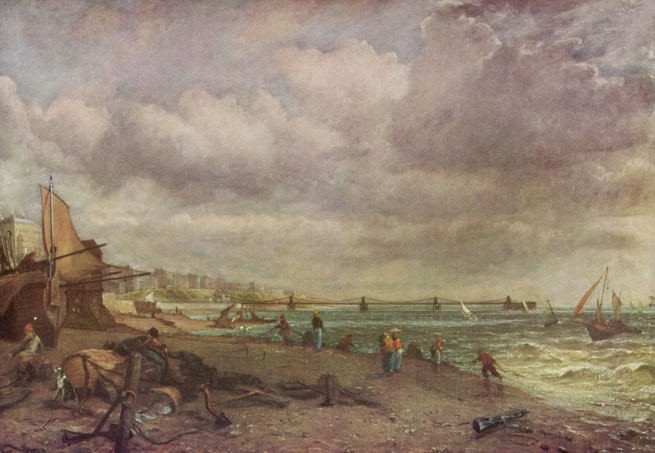 The Chain Pier painted by John Constable in the 1820s
The Chain Pier painted by John Constable in the 1820s
Brighton Chain Pier Swept Away
Damage to Rottingdean Electric Railway
The Old Chain Pier at Brighton was completely destroyed on Friday night by a violent gale from the south-south-east, as briefly reported in our Saturday's issue.
The collapse occurred at about half-past ten, when the two central piers fell with a crash, and the head very shortly followed. In half an hour nothing was left but a portion of the first pier, the whole of the flooring and connecting chains having been swept away. The fabric of the pier vanished in a moment, and the huge timbers carried westward by the current did great damage along the whole of the front of Brighton.
Such was the violence of the waves that many tons of wreckage were thrown upon the Madeira Road. All the groynes in the neighbourhood suffered, and immense damage was done to fishing and rowing boats, and to the bathing machines.
Near the entrance to the Aquarium, a hundred of the huge timbers were rolled over and over in a corner formed by one of the groynes and the seats on this and the other groynes were washed away.
These extraordinary scenes on the front were witnessed by large crowds of people. The pier fell with a tremendous crash which was distinctly heard two miles away.
The pier was condemned by the borough surveyor two or three months ago, and for the past month had been absolutely closed to the public.
Though the night was stormy, the crash attracted hundreds of townspeople to the front.
The damage did not end with the sweeping away of the Old Chain Pier, for the enormous waves dashed the great iron girders against the piles of the new Palace Pier now in the course of erection, smashing away two piles completely and doing considerable mischief to other portions of the cast-iron framework.
Volk's Electric Railway, constructed in the sea from Brighton to Rottingdean, was in several places swept away, and the railway, which was opened with such eclat last Saturday week, has thus early met with disaster. The new large car which had been taken over to Rottingdean was thrown over and smashed to atoms, the waiting-room and landing-stage at the Brighton end were wrecked, and the damage done here alone is estimated at £3,000 or £4,000.
The sea swept completely over the parade to the houses opposite, and great injury was done to boats and bathing machines. Great damage was also done to Brighton West Pier, and on Saturday morning, when several people were on the pier, their return was cut off by the collapse of a portion of the deck near the shore.
Great encroachments have been made by the waves on the Madeira Road.
Brighton has some of the finest wooden groynes on the coast, but several are now little more than gridirons. Some of the smaller groynes have vanished entirely. The storm will costs the town alone something like £5,000 or £6,000, possibly more.
The exceptional damage that has been done is attributed partly to the fact that the gale came from the south-east, a quarter whence strong winds rarely prevail at Brighton, where the danger most arises from south-westerly gales, to meeth which the defences are specially adapted.
Saturday will long be remember in Brighton - probably as "Wrecker's Saturday" - for shoals of children and, indeed, persons of all ages, were to be seen throughout the day swarming to the foreshore and carrying away the more portable fragments of timber that the sea cast up. Scores upon scores of persons also were seeking for nails and small portions of wood to retain as mementoes of the The Chain Pier.
- originally published by The Leeds Mercury, 7th December 1896




Rate and Review
Rate this article
Review this article
Log into OpenLearn to leave reviews and join in the conversation.
Article reviews